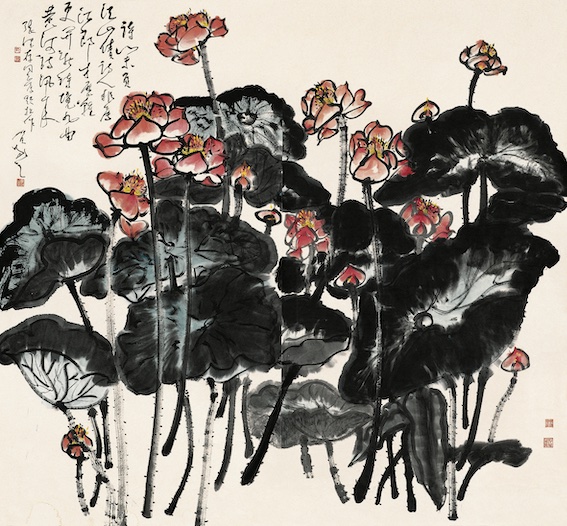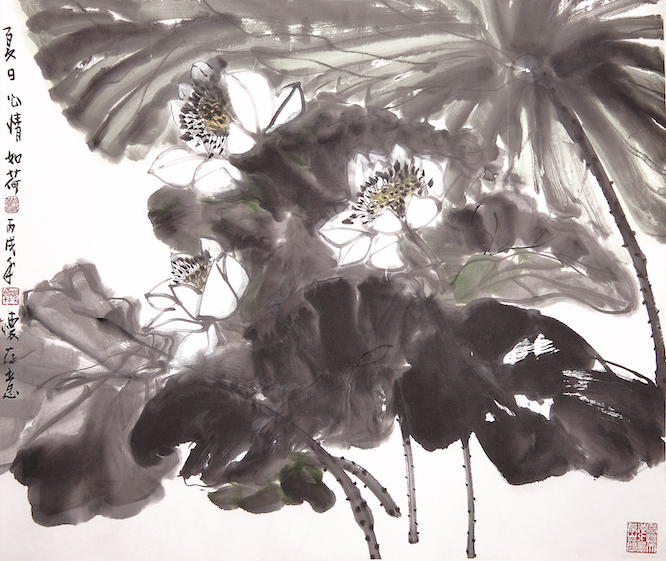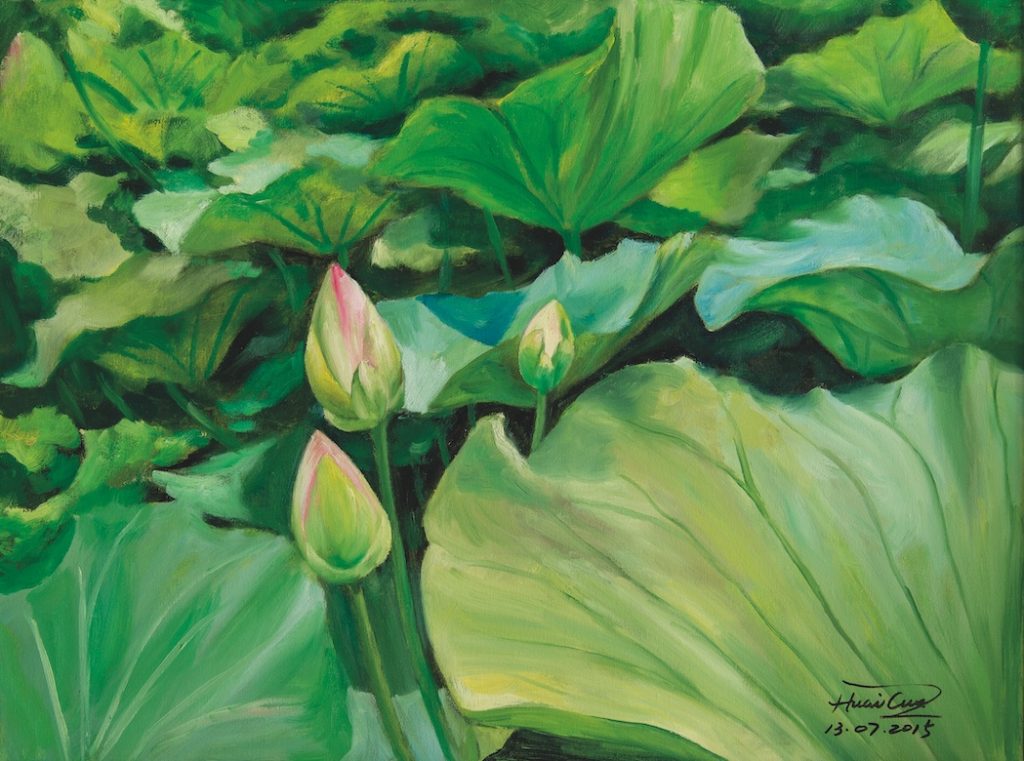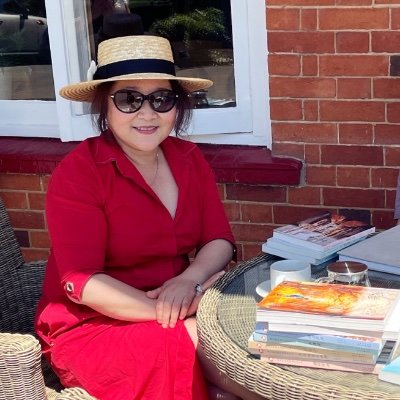Huaicun Zhang is an artist in many mediums: a poet, author, painter and calligrapher. The breadth of her body of work is matched only by the breadth of subject matter: from children’s literature, to high-brow poetry and essay collections, to contemporary painting. She is a member of the Royal Society of British Artists and the Chinese Writers Association.
Her upcoming solo exhibition in London, entitled Huaicun’s World offers a glimpse into the world of an artist with a prolific output – one who is sure to leave a giant footprint on the contemporary art scene.
Can you tell us about your upcoming exhibition Huaicun’s World – Blossom.
My solo exhibition at Mall Galleries is my first in London, although I have shown my paintings all over the world. I’m showing 120 works, including my traditional Chinese ink paintings, oil paintings, and illustrations from my children’s books. Alongside my works I’ll also be showing some of my collection of handmade brushes, pigments and seals and stamps made from jade and various stones.
I always like to have a big garden, so that there are different flowers blooming in each season. As a child, every day after school I would sit in the garden, watching the flowers planted by my grandparents and listen to the flowers blooming and whispering in the wind. I continue this with my own family, drinking tea and discussing the secrets of the garden being so lively. My grandma would always say every flower has a soul, and the moment it blooms is the most beautiful and stunning moment. So I hope I can bloom in my own world like a flower.
This exhibition includes many paintings inspired by the garden of my childhood and my current garden in London, including many of lotus blossoms. I often imagine my world as a lotus pond. I frequently use the Lotus flower as the theme in my work. In Chinese culture the lotus is sacred and a symbol of purity and elegance, so of course, many painters have portrayed the lotus flower in various forms, so I want to find ways to paint it in my own unique way. So I draw all kinds of lotuses, sometimes in full bloom after the rain, or as new buds in a pond.
Your body of work consists of traditional Chinese paintings, such as calligraphy, and other paintings. Can you tell us about the significance (to you) of continuing a tradition?
I always believe it is very important to carry on a tradition. Because tradition originated from life, and every art form such as literature and art is based on life. It is just like us, tradition is evolving and changing rapidly with our lives and the world. We are all a factor of the development of the tradition, we are also the witness of the evolution of tradition in its current shape.
I grind my own pigments for inks using the traditional method. Some of the equipment for this will be on display as part of the exhibition. These processes play an important part in my practice and create a strong feeling of continuing these age old traditions.
As a follow up, do you think that tradition can be reinterpreted and given a new lease of life (such as Wang Dongling or Cai Guo-Qiang’sworks) or it should honour its original manifestation?
On the basis of tradition, we can transform the tradition into a new style. Reinterpreting the tradition does not mean to discontinue it. Even if you break the tradition, it is still supported by the traditional factors. Reinterpretation is progress, and it is developing with the spirit of a different era. A new interpretation is an enhancement of a tradition. Just like the two artists that are mentioned, they have reinterpreted tradition and integrated their own thoughts and feelings into it. So the tradition is given a new life in a different form.
Some of your other works draw from a range of inspiration (such as impressionism, realism). How would you describe your style?
In terms of style, I always love to challenge myself with different art movements by drawing inspiration from great impressionist artists and realist artists. My art is still evolving as I keep on trying different styles. I cannot say I have found a particular style that I would like to stick with for the rest of my life. I will keep looking for the word to describe my style one day. Or I may even create my own style and call it Huaicun’s style!
How important is it to integrate the East and the West (through art) and how do your works do this?
The integration of western art with far east aesthetics goes back long time. Before we had photography, the West was eager to find out what the world looked like in the East. Many great artists such as Monet, van Gogh, Renoir had added some Asian aesthetic to their works to show the people the mysterious and beautiful East. However, there has been very little references on how western art influenced Chinese art except for the use of colour pigments.
For me, I think my childhood in China and my days in the UK helped me to slowly fuse more classic western styles with Chinese influences. Especially, Mr Wu Guanzhong had a huge influence on my longing to integrate western art with Chinese ink. He combined oil pigments and Chinese ink so flawlessly. He said, Chinese ink is the river, and oil pigments are the road. I am slowly following this path in my art works, by looking for different western art factors in my Chinese ink paintings. Such as using the bright red colours to contrast with the dark ink.
Can you tell us more about your poetry?
Besides painting, I always love to use poetry to write down about the vast and beautiful grassland of my childhood, I have been trying to capture for all time. After my daughter was born, I put all my love for her in my poetry. Every word she spoke to me was like a little poem that I had to write down. This also leads to my first co-published book Pencil Tree in 2004 with my daughter. Parents and children love reading our words of love and finding out our cute little world where everything is so magical. I fell in love with the feeling of writing poetry for children, this help me to keep the inner child in my heart and create more imaginative and fun works in my life. Pencil Tree was the most popular book after it was published, more than 100,000 copies were printed in 2004 and sold out in three months. It was shortlisted in the National Outstanding Children’s Literature Award in China. I was also awarded as ‘the top 10 most enchanting poet’ in China. It is one of my proudest works of all time.
What are your thoughts on the intersection of visual art and poetry? Where do you draw the line between the two?
Visual arts are all the arts that are within the reach of our eyes, the arts that are within reach of our eyesight. For me, poetry and visual art is inseparable. When there’s art there will be poetry, when there is poetry, there will be art. One is to pay more attention to material and image, and the other pays more attention to artistic conception and is more spiritual and internal.
Does life imitate art or does art imitate life?
This question is the most classical and the core of Chinese traditional culture. Art comes from life and goes beyond life. To me in my life, life is an art, and art is life.
Huaicun Zhang’s exhibition is at the Mall Galleries, The Mall, London SW1, running from the 11th to 23rd July 2022.







 Saving...
Saving...